By Chris, Five Star Ranch Staff Writer
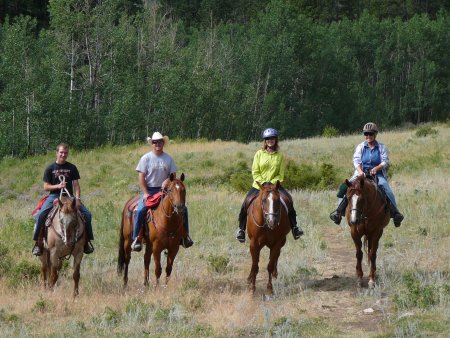
My 14 year old daughter is in the market for a new trail horse. I sat down with her and we came up with a list of characteristics that she deemed important for her future trail horse to have. She also came up with good questions to ask and tests to put a candidate horse through that would determine whether the horse possessed the trait.
The following list are things to consider when selecting a trail horse. Something important to keep in mind is that the intended use of the horse is an important factor in deciding what qualities you desire in a horse. If your intended use is showing or breeding, you may have significantly different criteria.
1. Is the horse spooky? While any horse will spook, a good trail horse shouldn’t overreact and put you in mortal danger every time they encounter a new obstacle. You want a confident horse that will take notice of something new, but not necessarily leap 10 feet sideways every time the horse turns a corner.
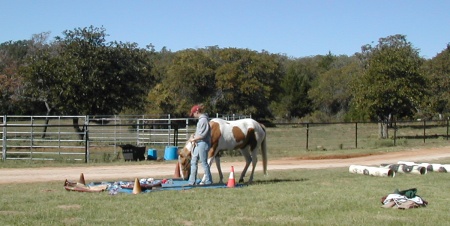
Test: A good initial test is to put the horse in a round pen or riding ring and have it go through a series of obstacles commonly used in competitive trail classes. You might have the horse walk over a tarp or poles on the ground. Ride the horse and see how difficult it is to open and close a gate. Try dragging something while walking or riding a horse. Word of caution here. Don’t tie anything to the saddle. Hold the rope to whatever you’re dragging in your hand so you can drop the item in case the horse goes bonkers.
The ultimate test to see how spooky a horse is, is to actually do a trail ride on a trail that is unfamiliar to the horse. Pick a trail that has a variety of obstacles to see how the horse deals with new situations. Have the horse cross ditches, creeks, walk by signs, cows, etc to see how the horse reacts. How does the horse react to people or bikers on the trail? Will the horse walk through water without throwing a fit?
Most horses will react and shy to new things. Don’t disqualify them just because they react, watch how they work through being frightened. Gauge the extent they react.
Most horses will become desensitized the more you work and ride with them, but some horses are naturally more spooky than others. These tests will give you insight into where the horse fits in the spookiness department.
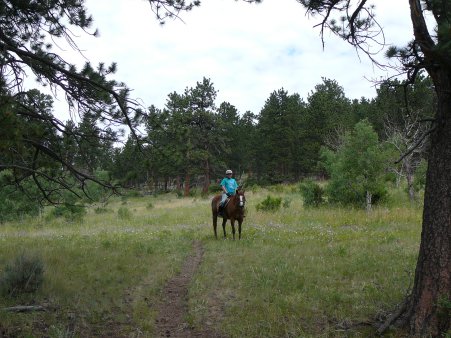
2. Is the horse herd bound or barn sour? Horses are gregarious by nature. They survive in the wild as a herd watching out for each other, so it follows that most horses are socially oriented. However, there is a difference between a horse being social and one that rears or becomes dangerously disobedient when you ride away from other horses.
Test: The only way to learn how herd bound a horse is, is to ride the horse alone. Will the horse ride alone or up front confidently? Go on a ride and take the horse off by itself. Does the horse get nervous as soon as it gets out of sight of other horses? Does the horse fight you when you attempt to leave the barn area?
You can work with herd bound horses to get them to be more confident with you, the rider, but it takes time and commitment. It would be nice to know the extent of the herd boundness prior to purchase. If a horse reacts strongly to being alone, you may want to pass on it in favor of one that is less herd bound.

3. Does the horse have comfortable gaits? If you’re going to be in the saddle for hours, it would be nice to have a horse with comfortable gaits.
Although I personally love my normal gaited Quarter horse, many of my trail riding friends have elected to go with gaited horses. Gaited horses are often more high strung than Quarter horses, but its hard to beat a gaited horse in comfort.
Test: Ride the horse at every gait. Can you sit the trot and lope easily? Much of a horses gait is attributable to good basic conformation. If evaluating horse conformation isn’t your strong point, tap into a friend who knows it or read some good horse conformation books. Or just ride the horse and see how comfortable it is.
4. Does the horse have good ground manners? You want a horse to be safe to handle and easy to work around. This is especially important if the rider is a youth or less experienced rider.
Test: Put the horse through activities you will be doing on a regular basis and watch how quiet it is. Put on a halter and lead it around. Back the horse in the halter. Load the horse into a trailer. Bath the horse. Put the horse into cross ties. Pick the horse’s feet. Put fly spray on the horse. Saddle and bridle the horse. Mount the horse. Does it stand quietly or do you have to constantly correct the horse? If you have to constantly fight the horse going through day to day activities, you may want to pass on it.
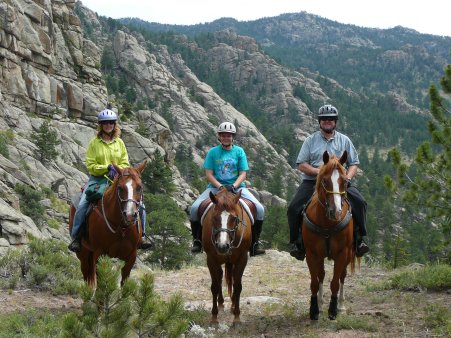
5. A good trail horse should have a decent level of training. You don’t need a level 4 Dressage horse to ride the trails, but a horse that rides easy will be more enjoyable. If your ride is fun, you’ll be more inclined to ride more often.
Test: Ride the horse at different gaits and in patterns like circles or figure eights. Does the horse bend around urns or lean to the outside? How well does the horse handle transitions between gaits? Stop the horse. Does it fight you or pull on the bit? Will the horse back easily? Will it side pass? Opening and closing gates is much easier with a horse that responds to your leg cues. Ride the horse up and down hills. Does it stay balanced when the ground isn’t flat? Will the horse stop at the bottom of the hill or does it try to run? If you take the horse out in an open field, does it continue to listen to you or does it think it’s time to run?
6. What vices does the horse have? Horse vices can be in the form of kicking, biting, cribbing, weaving, or any other behavior that is undesirable.
Test: Does the horse kick? Look in its stall and corral. Does the horse crib on every piece of wood it comes in contact with? Does the horse paw and get nervous when tied up?
Some vices are curable through training. Others, like cribbing, are nearly impossible to extinguish. If a horse is perfect in every way, but cribs, you may still buy it for a riding horse and plan to put on a cribbing strap. Its just a good idea to know what your getting in advance so you aren’t surprised when you come out one day and your stall looks like it was attacked by a pack of hungry beavers.
Try to observe how your horse reacts around strange horses. If the horse is especially aggressive toward horses outside its herd, it would be wise to know that prior to going on a large trail ride.
7. What is the overall appearance of the horse? While looks should be secondary, everyone likes to have a good looking horse with decent conformation.
Test: Take some snapshots of the horse from different angles. Then examine if the legs are straight and if the horse is proportionally balanced. A trail horse doesn’t have to be a halter champion, but good confirmation is often an indicator of a comfortable ride and long term health.
Many riders have a color preference when it comes to their horses. Just be aware, that when color is paramount in breeding, you may lose out on ride, disposition, and conformation. Look at the whole package and then decide. The sturdy sane sorrel may bring you more hours of joy than the flashy color-of-the-month horse that endangers your life every time you mount up.
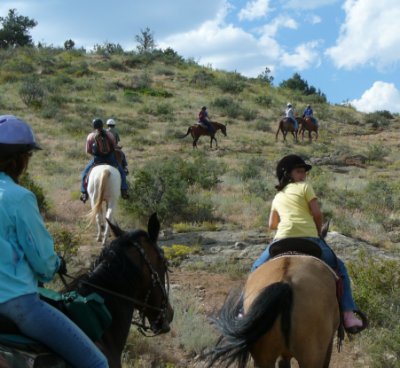
8. Horse Size. A riding horse should be large enough to comfortably carry the weight of the rider. That leaves a lot of variance for preference on horse size and intended use.
If riding the back country on wooded trails is your thing, there are some advantages to having a shorter horse that allows you to more easily dodge low hanging limbs. Also, if you have to dismount your horse on the trail, having a horse you can mount easily is helpful. Often smaller horses are more maneuverable in rough terrain than their giant horse cousins.
In my daughter’s case, she’s a teenage girl who likes to ride bareback, so having a slightly shorter horse she can climb on without stirrups has some distinct advantages.
9. Health Condition. Obviously you want a healthy horse for your riding horse, but there are some things to evaluate when deciding on a horse. Does the horse show any lameness? What is the condition of the horse’s feet? Does it have corrective shoes?
What is the condition of the horse’s teeth? Often problems that appear as training or discipline issues are actually teeth problems. Teeth issues can also affect the overall condition of a horse. If the horse can’t chew properly, it may not be able to get all the nutrients from its food so its body condition and coat may appear poor. While bad teeth don’t disqualify a horse, knowing if the horse is in need of dental work would be wise to know.
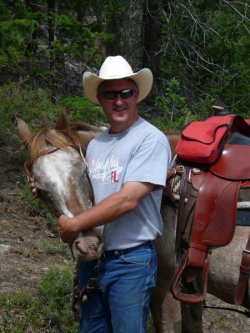
10. What is the horse’s age? For a trail horse, younger isn’t always better. A seasoned old timer is often the wisest safest trail horse. Riding an older horse allows you to relax and enjoy the scenery more than if you were on an inexperienced green horse still learning the ropes. So don’t disqualify a horse on age. I know several 30 year old horses still happily trail riding.
While many of us know a lot about horses, we highly recommend that you get a professional vet check before you buy.
11. What’s the horse’s personality like? Is the horse friendly or does it act aggressive to humans or other horses. This has more to do with how well you’ll bond with the horse than how it rides, but it contributes greatly to how much you will enjoy the horse.
When you walk in the stall, does it pin its ears back and turn its rear to you?
Will the horse let you lead another horse while you’re leading your horse? Can you pony another horse? When you’re in the pasture, does the horse come to you or is it hard to catch? If you dismount and drop the reins, does it try to leave or does it stand there?
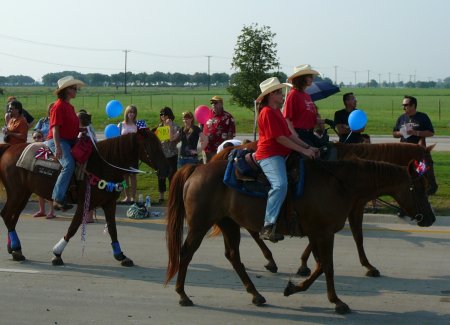
12. Will horse ride double? This is probably not something that everyone will care about, but for a youth rider, this is an important must have.
From a trail rider’s perspective, there are some sound reasons to have a horse that will ride double. If you’re ten miles from the trailhead and your partner gets bucked off her horse, it might be useful to have a horse that rides double without bucking. Also, if you ever want to use the horse as a pack horse, its nice to have one that graciously accepts extra weight on its back. My husband once had to carry a friend’s saddle back to the trailhead when their horse was injured on the trail and couldn’t carry the saddle. Having a calm trail horse helped a friend out of a jam.
Parting Thoughts on Selecting Your Horse
As you can see there are many things to consider when buying a horse. Your experience and the activities you want to do with the horse factor heavily into which horse will make you the most happy. Remember that there is no such thing as the perfect horse. All horses have good and bad things about them. Also remember that with handling and training many behavioral problems can go away.
See you on the trails!
Recommended Books on Trail Riding
The following books are excellent resources for information on trail riding. All give practical advice on training your trail horse and being safe on the trails.